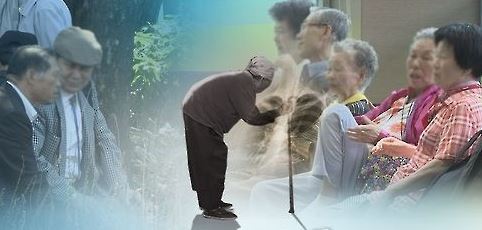Household savings rate to log minus growth in a decade: report
By Catherine ChungPublished : Aug. 2, 2017 - 10:09
The savings rate of South Korean households is expected to lapse into negative territory in a decade due the country's rapid population aging, a central bank report said Wednesday.
The Bank of Korea report estimated the household savings rate to start to register negative growth starting in 2026 in step with the country's fast population aging.
The figure is forecast to fall from 8.9 percent in 2015 to -3.6 percent in 2030, when the ratio of people aged 65 and older to total population is likely to rise to 24.5 percent from 12.8 percent over the cited period.
The savings rate represents the ratio of money set aside by households from their total disposable income. A negative reading means more households are disposing of real estate or financial assets for spending due to falling income.
The Bank of Korea report estimated the household savings rate to start to register negative growth starting in 2026 in step with the country's fast population aging.
The figure is forecast to fall from 8.9 percent in 2015 to -3.6 percent in 2030, when the ratio of people aged 65 and older to total population is likely to rise to 24.5 percent from 12.8 percent over the cited period.
The savings rate represents the ratio of money set aside by households from their total disposable income. A negative reading means more households are disposing of real estate or financial assets for spending due to falling income.

Most individuals see their income tumble after retirement, but their consumption, including medical costs, does not drop sharply, giving them less room to save.
According to the report, Japan has seen its household savings rate sink into negative territory because of an aging population. The figure fell to -0.5 percent in 2014 from 11.6 percent in 1994, as the ratio of people aged 65 and older surged to 25.7 percent from 13.9 percent over the cited period.
South Korea has been gripped by fast population aging. The country is widely predicted to become an aged society in 2017 with the ratio of people aged 65 and older hitting 14 percent of its 50 million population. It is forecast to emerge as a super-aged society in 2026, with the figure hovering above 20 percent.
Meanwhile, the report predicted South Korean households' preference for safe assets to gather further ground in the years to come. The ratio of bonds and other risky products to household financial assets is projected to decline to 13.2 percent in 2030 from 19.4 percent in 2015.
However, the ratio of cash and bank deposits is expected to climb to 51.6 percent from 43.1 percent over the cited period, with the figure for insurance and pensions gaining to 35.2 percent from 31.1 percent.
"As flight to safety grows in step with an aging population, there is a high possibility that households will tend to manage their assets in a stable manner to prepare for old age, while elderly retirees may become conservative about asset management," the report said. (Yonhap)









![[KH Explains] How should Korea adjust its trade defenses against Chinese EVs?](http://res.heraldm.com/phpwas/restmb_idxmake.php?idx=644&simg=/content/image/2024/04/15/20240415050562_0.jpg&u=20240415144419)








